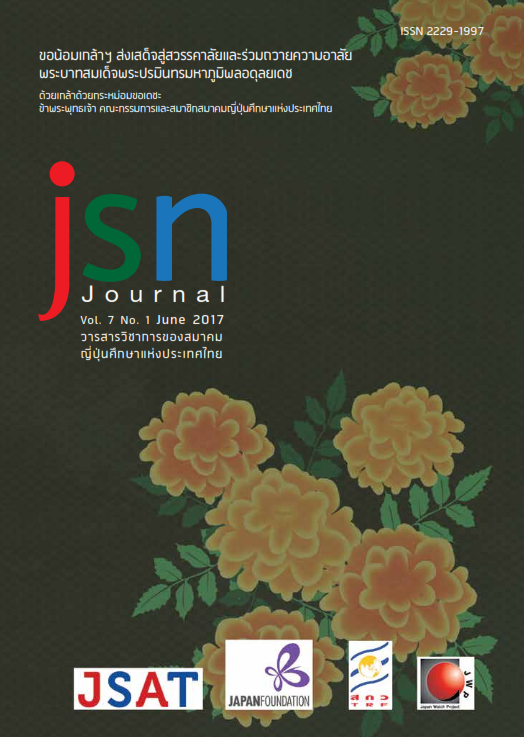A Study of the Usage of TE, TEKARA, TAATODE among Thai Learners of Japanese in Eight Universities
Main Article Content
Abstract
This research aimed to study the usage of TE, TEKARA, TAATODE among Thai learners of Japanese in 8 universities. Participants were 213 learners studying in 3rd and 4th years. They were collected by a purposive sampling method from 8 universities: 2 from the north, 1 from the east, 1 from the north-east, 2 from Bangkok and the metropolitan region, and 2 from the south. The instruments were 2 types of examinations that were calculated by percentage. One was a three-option multiple choice examination. The other was a usage examination including 12 items with Thai meaning. The findings revealed that the learners were able to correctly use TE and TAATODE in the usage examination more than 50 percent which were 78.87 and 57.90, respectively, while the learners were able to correctly use TEKARA less than 50 percent which were 41.31 and 30.99 in both examinations. The findings showed that TEKARA was the most mistaken and problematic form for Thai learners.
Article Details
ข้อความและข้อคิดเห็นต่างๆ ในบทความเป็นของผู้เขียนบทความนั้นๆ ไม่ใช่ความเห็นของกองบรรณาธิการหรือของวารสาร jsn Journal
References
สมาคมส่งเสริมเทคโนโลยี (ไทย-ญี่ปุ่น). (2557).ไดจิ 1 ภาษาญี่ปุ่นชั้นต้น. กรุงเทพฯ: สำนักพิมพ์ภาษาและวัฒนธรรม.
สมาคมส่งเสริมเทคโนโลยี (ไทย-ญี่ปุ่น). (2554). พจนานุกรมรูปประโยคภาษาญี่ปุ่น. กรุงเทพฯ: สำนักพิมพ์ภาษาและวัฒนธรรม.
สมาคมส่งเสริมเทคโนโลยี (ไทย-ญี่ปุ่น). (2558). มินนะ โนะ นิฮงโกะ เล่ม 1. (พิมพ์ครั้งที่ 31). กรุงเทพฯ: สำนักพิมพ์ภาษาและวัฒนธรรม.
สมาคมส่งเสริมเทคโนโลยี (ไทย-ญี่ปุ่น). (2559). มินนะ โนะ นิฮงโกะ เล่ม 2. (พิมพ์ครั้งที่ 31). กรุงเทพฯ: สำนักพิมพ์ภาษาและวัฒนธรรม.
สมาคมส่งเสริมเทคโนโลยี (ไทย-ญี่ปุ่น). (2558). มินนะ โนะ นิฮงโกะ เล่ม 3. (พิมพ์ครั้งที่ 23). กรุงเทพฯ: สำนักพิมพ์ภาษาและวัฒนธรรม.
庵功雄 (2014).「文法シラバスの作成を科学する」『公開シンポジウムシラバス作成を科学にする―日本語教育に役立つ多面的な文法シラバスの作成―』, 3-16.
庵功雄他 (2001). 『中上級を教える人のための日本語文法ハンドブック』東京: スリーエーネットワーク.
(2008). 『初級を教える人のための日本語文法ハンドブック』東京: スリーエーネットワーク.
岩田一成 (2012). 「予稿集原稿:初級シラバス再考―教材分析とコーパスデータを基に―」『広島市立大学発表ハンドアウト』広島: 広島市立大学.
(2014). 「口頭表現出現率から見た文法シラバス」『予稿集シラバス作成を科学にする―日本語教育に役立つ多面的な文法シラバスの作成―』, 17-26.
王蕊 (2009). 「日本語上級レベル学習者の接続表現の使用状況に関する調査―中国語母語話者のストーリーテリングテストを中心に―」『ポリグロシア』 17, 117-128.
加藤紀子 (2002). 「作文データから考える初級の文法指導 接続詞・接続表現を中心に」『第14回日本語教育連絡会議報告発表論文集』, 31-35.
寺村秀夫 (1990). 『外国人学習者の日本語誤用例集ー特別推進研究日本語の普遍性と個別性に関する理論的及び実証的研究』大阪: 大阪大学.
(1992). 「時間的限定の意味と文法的機能」『寺村秀夫論文集I―日本語文法編』東京: くろしお.
日本語教育事典(縮刷版12刷発行). (2000). 東京:大修館書店.
桝井雅子 (2004).「「〜タアトデ」を用いた時間構文の研究:「テカラ」及び「タアト」との異同を考える」『熊本大学留学生センター紀要』 8, 13-30.
水野マリ子 (2001).「「ーてから」と「ーたあとで」―文の切れ続きに関する一考察―」『神戸大学留学生センター紀要』 7, 69-77.
吉永尚 (2012).「テ形における統語的考察」『園田学園女子大学論文集』 46(1), 113-123.


